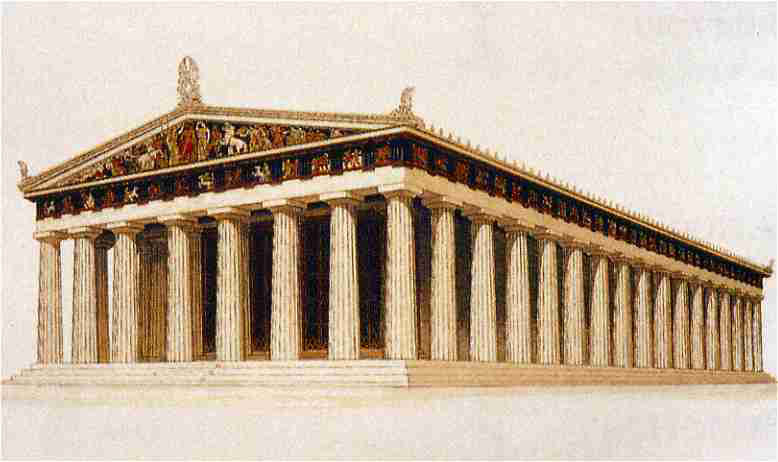Eternal Forms: Greek Architecture Then and Now
 Unlike
the pyramids, which attempted to keep people out, a Greek temple was a public
building that was open to anyone. Notice that the Parthenon, on the left,
has no "front door." There is no side that is not open to the
public and a person may approach it and enter from any direction. A Greek
temple was not a place for the solitary worshiper to go, but a community center
where people could meet together. But more than this, a Greek temple was
meant to be seen from the outside.
Unlike
the pyramids, which attempted to keep people out, a Greek temple was a public
building that was open to anyone. Notice that the Parthenon, on the left,
has no "front door." There is no side that is not open to the
public and a person may approach it and enter from any direction. A Greek
temple was not a place for the solitary worshiper to go, but a community center
where people could meet together. But more than this, a Greek temple was
meant to be seen from the outside.
 When
Pericles ordered the Parthenon to be built, he wanted it to perform a certain
function in Greek society. Like Pythagoras and Plato (who lived after
him), Pericles believed that truth was perfect. This meant that the
relations of its harmony and proportions where exact and eternal. By
building a temple with perfect harmony and proportions, it would stand as a
model to the communities' deepest and most cherished values. Since most
Greeks spent the majority of their time outside during the day, they would be
able to see the Parthenon from anywhere in Athens. Thus it stood as a
reminder to them of truth. It reinforced the main ideas of the polis.
When
Pericles ordered the Parthenon to be built, he wanted it to perform a certain
function in Greek society. Like Pythagoras and Plato (who lived after
him), Pericles believed that truth was perfect. This meant that the
relations of its harmony and proportions where exact and eternal. By
building a temple with perfect harmony and proportions, it would stand as a
model to the communities' deepest and most cherished values. Since most
Greeks spent the majority of their time outside during the day, they would be
able to see the Parthenon from anywhere in Athens. Thus it stood as a
reminder to them of truth. It reinforced the main ideas of the polis.
NEXT
 Unlike
the pyramids, which attempted to keep people out, a Greek temple was a public
building that was open to anyone. Notice that the Parthenon, on the left,
has no "front door." There is no side that is not open to the
public and a person may approach it and enter from any direction. A Greek
temple was not a place for the solitary worshiper to go, but a community center
where people could meet together. But more than this, a Greek temple was
meant to be seen from the outside.
Unlike
the pyramids, which attempted to keep people out, a Greek temple was a public
building that was open to anyone. Notice that the Parthenon, on the left,
has no "front door." There is no side that is not open to the
public and a person may approach it and enter from any direction. A Greek
temple was not a place for the solitary worshiper to go, but a community center
where people could meet together. But more than this, a Greek temple was
meant to be seen from the outside.  When
Pericles ordered the Parthenon to be built, he wanted it to perform a certain
function in Greek society. Like Pythagoras and Plato (who lived after
him), Pericles believed that truth was perfect. This meant that the
relations of its harmony and proportions where exact and eternal. By
building a temple with perfect harmony and proportions, it would stand as a
model to the communities' deepest and most cherished values. Since most
Greeks spent the majority of their time outside during the day, they would be
able to see the Parthenon from anywhere in Athens. Thus it stood as a
reminder to them of truth. It reinforced the main ideas of the polis.
When
Pericles ordered the Parthenon to be built, he wanted it to perform a certain
function in Greek society. Like Pythagoras and Plato (who lived after
him), Pericles believed that truth was perfect. This meant that the
relations of its harmony and proportions where exact and eternal. By
building a temple with perfect harmony and proportions, it would stand as a
model to the communities' deepest and most cherished values. Since most
Greeks spent the majority of their time outside during the day, they would be
able to see the Parthenon from anywhere in Athens. Thus it stood as a
reminder to them of truth. It reinforced the main ideas of the polis.